|
ULA CIRCUIT BACKPACK
TEST SERIES BY JOHN R. WATERS
LONG-TERM REPORT
INITIAL REPORT - July 07, 2010
FIELD REPORT - September 21, 2010
LONG TERM REPORT - November 25, 2010
TESTER INFORMATION
|
NAME:
|
John R. Waters
|
|
EMAIL:
|
exec@bysky.com
|
|
AGE:
|
61
|
|
LOCATION:
|
White Lake, Michigan USA
|
|
GENDER:
|
M
|
|
HEIGHT:
|
5' 9" (1.75 m)
|
|
WEIGHT:
|
178 lb (80.70 kg)
|
|
BOOT SIZE
|
10.5 US
|
My backpacking began in 1999. I have hiked rainforests in Hawaii, Costa Rica, and Puerto Rico, on glaciers in New Zealand and Iceland, 14ers in Colorado and Death Valley's deserts.
I hike or snowshoe 6-8 miles (10 km-13 km) 2-3 times weekly in the Cooper Mountain range, with other day-long hikes on various other southwest and central Colorado trails. I frequently hike the mountains and deserts of Utah and Arizona as well.
My daypack is 18 lb (8 kg); overnights' weigh over 25 lb (11 kg). I'm aiming to reduce my weight load by 40% or more.
INITIAL REPORT
PRODUCT INFORMATION & SPECIFICATIONS
Manufacturer: ULA Equipment
Year of Manufacture: 2010
Manufacturer's Website: http://www.ula-equipment.com
MSRP: US$ 200.00
Listed Weight: 36 oz (1.2 kg)
Measured Weight: 39 oz (1.1 kg)
Listed Volume: 4200 cu in
Recommended Maximum Load: 35 lb or less (16 kg)
Recommended Base Weight: 15 lb or less (7 kg)
Hip Belt Sizes Available: Extra Small, Small, Medium & Large (26 - 42 in/66 - 107 cm)
Hip Belt Size Tested: Medium - 38 in (97 cm)
Torso Sizes Available: Small, Medium & Large (15 - 23 in/38 - 58 m)
Torso Size Tested: Medium - 19 in (48 cm)
Colors Available: Green with Black | 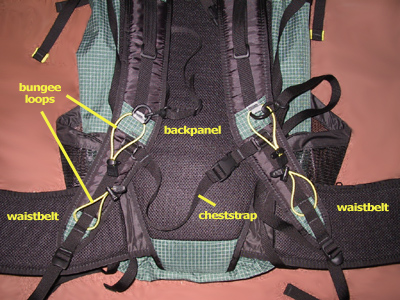 |
| Other details: (from ULA Equipment website) |
Integrated
* Internal Suspenion HoopEx
* Padded Backpanel
* Contoured Shoulder
* Front Shock Cord
* Front Mesh Pocket
* Adjustable/Bellowed Side Pockets
* Rolltop Closure
* Side/Top Compression Straps
* Dual Hipbelt Pockets
* Ice Axe/Pole Retention Loops
* Dyneema Gridstop |
Removable
* Hydration Sleeve (~1.4 oz/40 g)
* Internal Mesh Pocket (~1.1 oz/31 g)
* Water Bottle Holsters (~0.8 oz/23 g)
* Handloops (~0.8 oz/23 g)
* Single Aluminum Stay (~2.0 oz/57 g) |
INITIAL IMPRESSIONS
When the Circuit pack arrived it was noticeably light! The ULA-equipment.com Web site says it weighs in at 36 oz (1.02 kg) without the removable components. I put the pack on a scale with everything included and got 39 oz (1.1 kg). That leaves a lot of room to add stuff to get to ULA's suggested maximum load of 35 lb (15.9 kg). The last time I was on a flight for business, I packed a lot of electronic gear into a checked bag and didn't get over that weight limit.
The next thing I noticed was the tough mesh exterior pouch. All the dimensions of the pouches are shown on the enclosed photos. The mesh material is light but "hard" and feels really strong. It is kinda noisy, unlike flexible soft nylon mesh.
The hydration pouch and a smaller mesh interior pouch are removable via a unique click lock buckle. They make removing the hydration pouch and that mesh bag very easy yet they lock in very securely.
The hydration pouch has a top overlapping cover that has left and right exits for the hydration tube.
There are no other compartments inside this huge pack. It's a vast storage area that I know I can lose things in because most of the time I can't remember where I put stuff in my vest pockets. I will be using light-weight storage bags inside the main compartment so I can quickly locate items.
ULA says that EACH of the two exterior side mesh pouches can "accommodate two 1-Liter 'Big Slam' style bottles" or larger Nalgene-style bottles. They say that "most people" will be able to reach back and get the bottles and replace them. That, we shall see and report on in the Field Report.
The top extension adds a lot of extra space, making the pack a full 12 in (30.5 cm) higher. The extension rolls and closes like a dry-bag.
There are plenty of tie points, including 4 yellow adjustable bungee loops on each shoulder strap and nice adjustable hook and loop loops on the back for securing poles or items up to 3 in (7.6 cm) in diameter. The waist belt pockets on left and right sides are quite large. There are also 4 adjustable hip straps, 2 on each side so that the waist belt can be adjusted top and bottom for a better custom fit. The yellow bungee loops are designed to hold a tall water bottle right out in front of each shoulder strap.
I am anxious to pack this baby up and put it through field testing. The back support looks minimal but good, so I am looking forward to how this pack will handle vigorous climbs up steep trails and scrambles over boulders and me falling on my butt going down a scree field.
READING THE INSTRUCTIONS
Unlike most pack vendors, ULA included instructions explaining how to "Saddle Up" and adjust the pack for proper wear. They also go over the major features of the pack, including the use of the yellow bungee loops for water bottles and the use of the adjustable 26 in (66 cm) webbing loops on the shoulder straps provided as a place to rest my hands, thumbs or wrist, which is an interesting concept that I am anxious to try out.
They also have an excellent video on their Web site that goes into a lot of detail that I wish every pack manufacturer would make available to their customers. For example, they show how the 4 yellow adjustable bungee loops on the shoulder straps are intended for holding tall thin water bottles right on the shoulder strap. If I had not found that video or read about the intended use in the enclosed instructions, I would have not guessed that was the intended use of those loops, nor would I have guessed what the rest straps were for. Of course, now I need to try these unique features out as part of the Field Test.
SUMMARY
This is certainly my lightest pack without seeming to have sacrificed on roomiest. I'm looking forward to pack it up and getting it out on the trails this weekend.
This concludes my Initial Report on the ULA Circuit Backpack. Please read below for the results of my first two months of testing.
FIELD REPORT
FIELD LOCATIONS AND CONDITIONS
This pack has been with me all across Colorado westward to Salt Lake City, Utah and then all across Wyoming from Salt Lake City, Utah back to Denver, Colorado. A hike into the Wet Mountains south of Florence, Colorado up to 8,120 ft (2475 m), the Cooper range in Fremont County, Colorado from 5600 ft to 7200 ft (1707 m to 2195 m) and to Denver, Colorado at around 5800 ft (1768 m).
Temperatures during this period ranged from 40 F to 102 F (4.4 C to 38.3 C). I've not only packed hiking stuff in this unit, but I've also loaded this pack up with radio gear when hiking to tower sites. I stress my test units out pretty well.
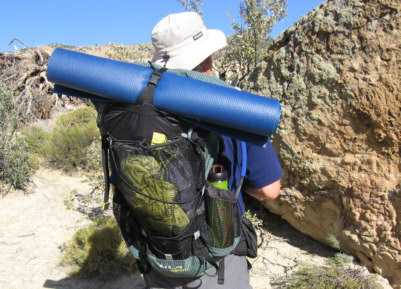 | | Rear View of Loaded ULA Circuit |
| 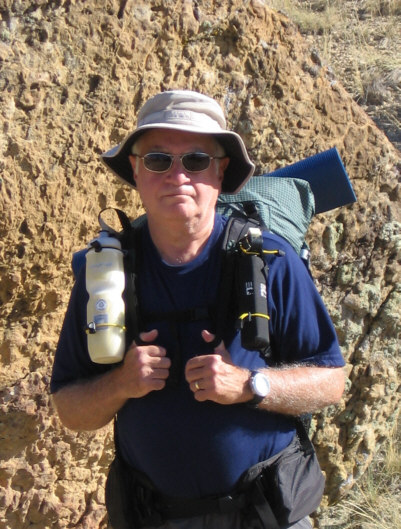 | | ULA Circuit Loaded and Ready to Go |
|
PERFORMANCE IN THE FIELD
This is a large pack. With the lid cover fully extended I have been able to load this baby up well. With the absence of interior compartments, I have had to use a lot of my small storage packs. I have many, of all different sizes and shapes that allow me to sort small and medium-sized items and organize my pack very nicely. These small storage packs can be found at most sporting stores, but I recently found nice ones at a local dollar store.
There are specific things I look for in a pack this size and I'll address them individually.
1. Low weight
2. Rain protection
3. Storage capacity
4. Fit/weight distribution
5. Storage flexibility
6. Durability
1. Low weight
This pack is not an ultra-light. It's a "very-light". Compared to some of the other packs I have of this size, this ULA is quite light. It will not add much to the "stuff" that I can load it up with. When packed with 30 or 40 lbs (13.6 kg or 18.1 kg) of stuffing, a few pounds (or kilos) extra of raw pack weight can be the straw on the camel's back. This pack allows me to toss in a few more items, yet is not a minimalist ultra-light.
2. Rain Protection
From the ULA website FAQ (because I could not say it better myself): "The top of the pack closes like a drybag (also known as a rolltop) very similar to what river runners use to create a water resistant seal for their gear bags. Basically, the back of the collar is slightly taller than the front. Once you are packed, the collar can be 'rolled' down upon itself to effectively create a barrier to water penetration. Once rolled, each side of the collar is buckled to the sides of the pack to hold the seal and to provide vertical compression to your load".
Yes, the top main compartment is covered very well. Water does bead up on the pack indicating the material is treated for water resistance. We have not hiked anywhere where it has rained though. All the areas we have been in are under extreme fire danger right now. Maybe for the final part of this test we can get some rain, but I poured water over the top and the fabric showed no sign of getting soaked and the water just beaded up and rolled off.
Anything in the outer mesh compartments, of course, is fully exposed to the elements.
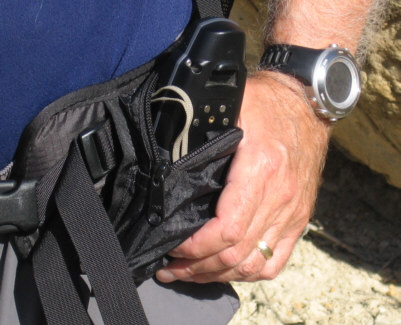 | | Hip Belt Storage Options |
| 3.Storage capacity
Basically, for storage, what's available is the large main interior compartment (which can go from 2400 cu in to 2900 cu in (39.3 l to 47.5 l) when the top collar is fully expanded), the hipbelt pockets, the front mesh pocket and the side mesh pockets.
All totaled that is 3,750 cu in. (61.5 l). The ULA website says 4,200 cu in. (68.83 l) but that's not what I get when I add up their volume breakdown listed on the site.
I've gotten a compressed, medium-weight down sleeping bag, 2-person tent (and in the last trek a 4-person, lightweight tent), TWO full 2 L hydration packs (or larger of course if I were not to insert them in the internal hydration bag and just used the main compartment), food for 2 days (bars, coffee, tea, jerky, snacks), bear bag, 50 ft (15 m) of rope, lightweight stove, headlamps, batteries, lightweight fleece, work gloves, toilet paper, and more into the main compartment easily. I strap my pad (foam) with the top compression strap and load my zoom binocs into one of the hipbelt compartments so they don't bang my chest when walking. My GPS fits into the other hipbelt pouch along with my cell phone. |
I use a hydration pack on longer treks and overnighters because I hate carrying empty bottles around. However, when I used the Circuit on shorter day hikes, I put 1/2 liter plastic bottles into the side pouches. They are easy to reach for removal, but not that easy to get back in (especially when there are two in the same pouch) while wearing the pack and trust that they are securely in place. Smaller bottles worked better for me than the larger ones though to get back into the pouch while wearing the pack. The cinch pull was easy to fasten to secure the bottles once I could tell I had them all the way into the pouch and to loosen up to get a bottle out.
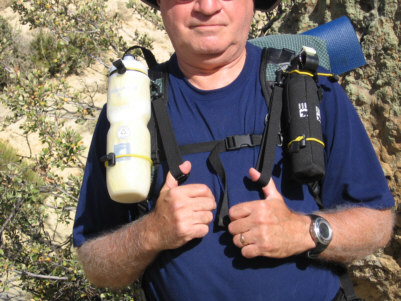 | | Water on the Right and Bear Spray on the Left |
My HTC Touch Pro Windows Mobile touch cellular phone fits either vertically or horizontally in either hipbelt pouch. Likewise for my Nikon compact zoom binoculars. There was still room in each belt pouch for a food bar, lip balm, and a few smaller items. | 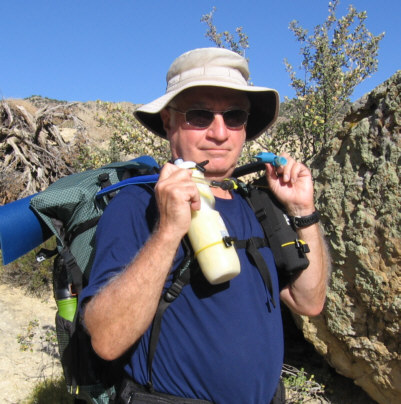 | | Two Hydration Tubes for More Water |
|
I can also strap my GPS to the top part of a shoulder strap with two wrap-around hook-and-loop ties to keep it as high as possible. Been doing this for years and it works well on the Circuit if I am not using the shoulder strap water bottle holder.
4 Fit/weight distribution
So far I have found the Circuit to be VERY comfortable to use under all conditions. The hipbelt is very comfortable to wear with no pressure points noticeable even under heavy load. All the strap and belt adjustments are easily accessible while wearing the pack. I sometimes reposition my pack up and down to change the weight load just to vary the load on my back and this has been very easy to do. The chest strap can be moved up and down on a slide on each shoulder strap, but I would like to see it to be able to move down maybe just one more inch (2.5 cm). To me it feels a little on the high side across my chest and I could not adjust it downward further. My jacket size by the way is a 42 in (106.7 cm) chest size. Otherwise, this has been a very comfortable pack to wear even when fully loaded.
I use hiking poles a lot because we hike over some pretty rough, rock-strewn terrain and poles are needed when going downhill to avoid slipping. I was wondering if I would ever use the "thumb rest straps" attached to the shoulder harnesses. Well, they do come in handy when resting and they also can serve as another loop to clip a thermometer or emergency whistle to.
Like all heavy packs, I have to be careful that all that weight doesn't pull me off balance backwards. I do not usually have issues with balance going side to side, but I find that there is a tendency to get pulled backwards when climbing rocks going up a steep slope. I don't see any difference using the Circuit, but like all packs, this backward force is minimized by putting as much heavy stuff as possible at the bottom of the pack. With everything being so light today, there usually isn't one specific item, other than water bottles and hydration packs.
5 Storage Flexibility
As I mentioned before, anything that can fall to the bottom of my packs and be difficult to find gets put into a storage pouch. I have a bunch of these of various sizes and colors. There is a small internal mesh pocket provided with the Circuit that serves the same purpose as the storage bags I purchased. It is removable and I use it so small items (like batteries and a flashlight) can be removed for use in the tent, etc.
I have tried using the shoulder belt water bottle holders. I used Propel 500 ml (16.9 oz) flavored vitamin water bottle that sort of fit and I tried a few other commercial 500 ml (16.9 oz) bottles that would not stay in place because they were too wide or too straight. The use of the shoulder strap bottle holders requires some experimenting with bottle size and shape. There is a video on the ULA site that shows the bottle shape and size they suggest for the shoulder harness water bottle holder: "tall and narrow" is what they say.
A 24 oz (710 ml) insulated Polar Bottle worked very well because it has indented ridges all around the bottle that the ties could grab into. In all, with two-2 L hydration packs, and enough of the proper-sized water bottles in the side pouches and under the shoulder strap loops, I could get up to about 8 L of water! That's 2.2 lbs (.998 kg) per liter, or 17.6 lbs (7.98 kg) of water!
Since the pack is rated at 35 lbs (35.9 kg) carrying capacity, that leaves me room for 17 lbs (7.7 kg) more of "stuff". Easy to do for a weekend or 3 or 4 days with a 3 lb (1.4 kg) tent, 2 lb (.91 kg) sleeping bag, 1 lb (.45 kg) pad, 8 oz (.23 kg) stove, etc. Heck, I can pack what I need easily under 10 lbs (4.54 kg) and have room for up to 7 lbs (3.2 kg) of food.
The biggest challenge I have with wide hipbelted packs is where to carry my 10 mm pistol and bear spray. Both use belt holsters. I have a holster for the pistol that slides over the top of a belt, but that is not secure enough for hiking since it can be pulled off easily when bushwhacking through trees (it has done that and that's why I won't use it when hiking any more).
The Circuit belt is wide and covers my pants belt so I cannot put the pistol holster on my pants belt. The only solution is to use a chest holster, which I do not have, or to use one of the side mesh pockets. I can put the pistol in a pocket and reach it pretty quickly and get it back in without taking the bag off. Of course, the safety must be on when doing this and I lose one water bottle pocket. Not a bad trade-off though to defend from a bear, mountain lion, coyote, rattlesnake or surprised backcountry "hemp" grower. My bear spray (one of the large grizzly canisters) does fit with an elastic strap across the shoulder harness, but fits much better into one of the shoulder harness water bottle bungees.
When the large compartment is fully loaded, the front mesh pocket does not have a lot of "give" so there isn't too much that will fit in there. In the photo, see that I stuffed a yellow rain jacket in there and I have been able to compress a wind jacket and a pair of gloves, but no large items will fit once the main interior compartment of the Circuit is full. | 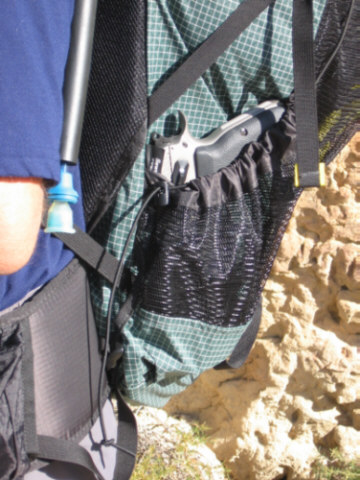 | | Even a Pouch for my Gun! |
|
6. Durability
I have not seen any wear and tear at all and the Circuit has been caught on branches and even broken branches it snagged on, scraped across rock and stuffed with junk of all sorts and tossed in the back of my Subaru with all my tools. It still looks new. The mesh is quite tough. Stiff, but tough.
SUMMARY
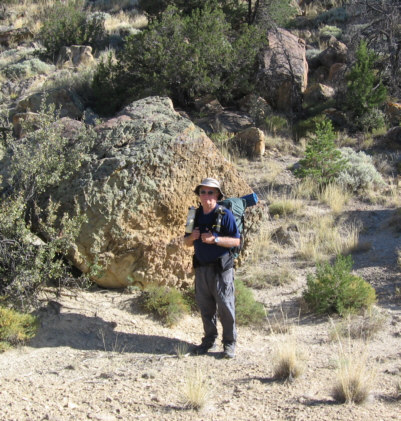 | | ULA Circuit on the Trail |
| I like this pack. It is lightweight without sacrificing features like an ultra-light pack may. There are plenty of optional tie-downs, external pockets and ways to mount and carry stuff. I don't see a way to strap down snowshoes using the standard straps and ties though, but there are tie points that would allow me to use my own tie downs to do so. I doubt if I'll see enough snow out here in Colorado where we are before the end of this test to put the Circuit through a winter trek. It's mid-September and it is 95 F (35 C) here today. But I am sure I'll continue to use this pack on long trips.
This concludes my Field Report after two months of testing the ULA Circuit. For my conclusions after two more months, please see below for the conclusion of my testing. |
LONG-TERM REPORT
WHERE AND HOW I USED IT
We tripped off on several day hikes in Colorado with the Circuit just to give it some more time on the trail to stress it. Granted there was PLENTY of room for day hiking, and having all the extra room didn't cause the pack to list or pull me from side to side. Of course, I do bring a lot of stuff even on day hikes: camera, binoculars, extra AAA batteries, food, at least a few liters of water, wind jacket and more food. Sure the Circuit is overkill on day hikes, but it also had more time being exposed to UV rays and very low humidity. Around here anything plastic exposed for several months gets so brittle that it falls apart when touched. No kidding. If I were to touch the solar patio lights we mounted in the ground a few years ago they would break into hundreds of tiny pieces. So any of our gear needs to be kept out of extremely long term exposure to the sun here at 5600 ft (1707 m) and higher. I often wonder what will happen to me in another 20 years.
An overnight bushwhacking across the Cooper mountain range behind our ranch is always fun and we took off to tent and enjoy the scenery. The Circuit packed well with the compact tent we were testing (in its own stuff bag that takes up less space than a rolled up sleeping pad), stove, fuel, wind jacket, OP Saks, dried food dinners for 2, food bars, jerky, outer layer, sleeping bag pad, blow up pillow, batteries, binoculars, a small bag of extra 10mm rounds for my pistol, wipes, zip bags, and lightweight sleeping bag. Pack weight with everything was about 40 pounds (18 kg) when departing, mostly due to all that water (4 liters, or about 1 gallon, weighs just about 8 pounds (3.6 kg).
My partner carried her sleeping bag, her sleeping bag pad and her own snacks and water, binoculars, camera, warmer clothes, etc. in her own pack.
There are no trails where we go. We bushwhack and keep a breadcrumb backtrack trail on the GPS. Of course, we can see for over 50 miles (80 km) being that we get up to 7,000 ft (2.1 km) or more, but having a nice backtrack to return home can save hours of going in circles due to canyons and such.
Since there is a pretty steep rise of 2,000 feet (610 m) or more in just 5 miles (8 km), and we are bushwhacking, the gear we use gets caught on tree branches frequently and gets a lot of abrasion from boulders and outcroppings.
The Circuit handled getting tied up on cedar trees quite well. I know that on all our trips I will get stuck on branches and need to pull and tug to get free and this trip was no different. The Circuit handled breaking off small branches very well.
On short treks, with the pack loaded to maybe 50% capacity, there was no swaying with all the weight down towards the bottom of the pack. The compression straps did allow me to tie the empty portion down. The empty portion didn't get caught on any more branches than usual while bushwhacking.
On the overnight trek, with a 40 lb (18 kg) load, it was still a challenge to get under branches that are 4 ft (1.2 m) or less above ground. If I can't break them or push them aside, I have to get over or under these obstacles. The pack did not pull me from side to side, going over or under all these bushwhacking challenges and stayed well attached to my body without the feeling it was going to lift off or come loose.
I didn't use the water bottle shoulder ties on the overnight trip because I didn't want to mess around with carrying empty bottles around. I wasn't sure if the empties would stay in place with all the motion and I didn't want to try and push them into the pack. Maybe on the next trip. So I did use two hydration bladders, a 1 liter and a 3 liter, and that worked very well. In theory, the pack will allow both hydration feed lines to be exposed, but that was too much stuff dangling in front of me that could also get caught on tree limbs. So I just used one at a time.
My GPS worked well mounted on the shoulder strap as reported before and I was able to insert my compact binoculars into the waist belt pouch on one side and my Touch Pro 2 Windows Mobile phone in the other. Being at those altitudes, we get cell service. Going down into the steeply sided ravines though, we do not.
So the Circuit has held up very well trekking in high mountain terrain. It is comfortable and a lighter weight than I am used to compared with other packs I've own. It is well laid out and easy to use.
SUMMARY
The ULA Circuit backpack has proven to be a durable and well thought out design. This is a large pack, getting very close to ultra-light in weight, yet designed to sustain rugged use and carry a load for multi-day trekking, especially where a lot of water needs to be carried. I have yet to use it in very frigid weather. Under low temperatures some products I've tested have had pieces break in sub-zero temperatures. So far this pack has been great for me. If there are any significant problems when I use this pack in sub-freezing temps, I will be sure to post an addendum here. Meanwhile, this appears to be a keeper for long excursions.
Thank you to ULA Equipment and BackpackGearTest.org for the opportunity to test this product.
John R. Waters
This report was created with the BackpackGearTest.org Report Writer Version 1.5
Copyright 2011. All rights reserved.
Read more reviews of Ultralight Adventure Equipment gear
Read more gear reviews by John Waters
Product tested and reviewed in each Formal Test Report has been provided free of charge by the manufacturer to BackpackGearTest.org. Upon completion of the Test Series the writer is permitted to keep the product. Owner Reviews are based on product owned by the reviewer personally unless otherwise noted.
|
All material on this site is the exclusive property of BackpackGearTest.org.
BackpackGearTest software copyright David Anderson |




